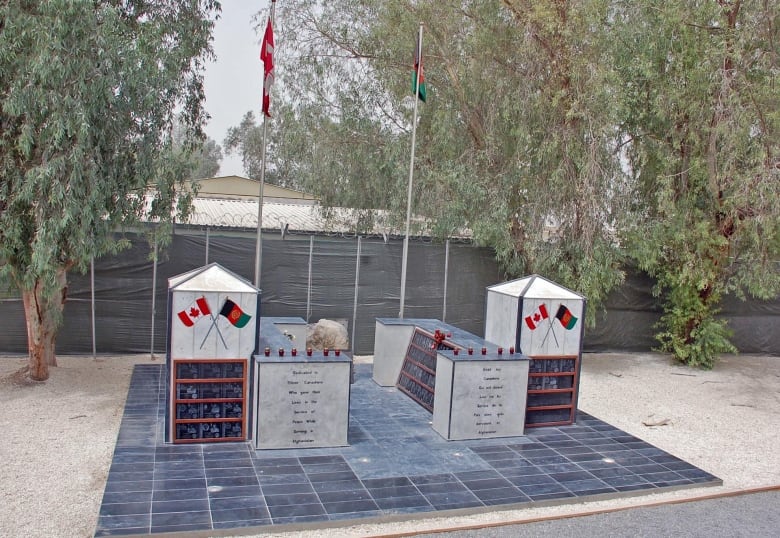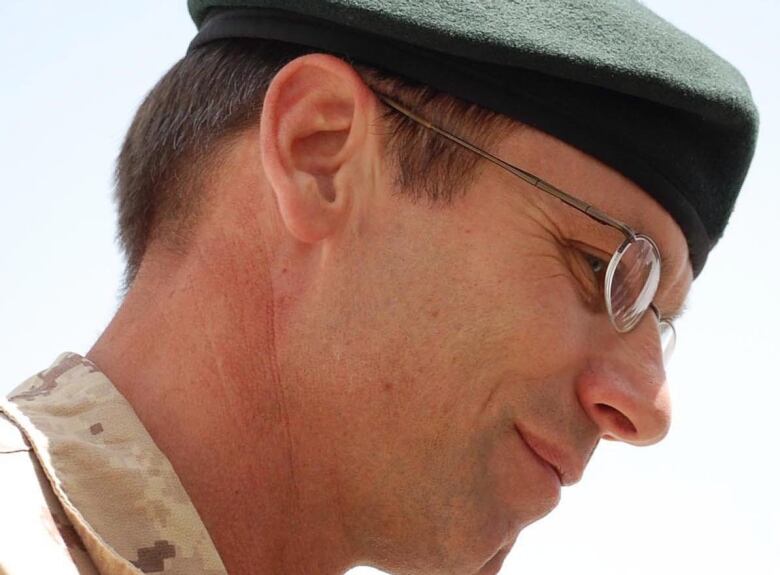Families, former commanders urge open access to rebuilt Afghan war memorial
Mother of fallen soldier says seeing the memorial helps the public better appreciate 'what was taken away'

A reconstructed memorial to Canadians and Americans killed during the Afghan war a moving tribute that once stood at Kandahar Airfield should be open and accessible to the general public, say former commanders and families of those who died.
National Defence has completed construction of a building to house the cenotaph at the military's new west-end Ottawa headquarters complex and will formally open the structure this fall, according to a spokesman and a posting on the federal government's tendering website.
The department advertised last week for an audio-visual company to support the inauguration on Oct. 27, but Jean-Marc Doucet, acting director the Ottawa headquarters transformation, said the date has not been entirely confirmed.
The cenotaph, which originally stood outside of the Canadian command post at the airfield in Afghanistan, was dismantled and shipped home following the end of combat operations in 2011.

It was reassembled into a temporary display that travelled the country in 2013 while officials tried to find a permanent home in Ottawa.
The tribute uses black granite plates 192 in all etched with the photographs of Canadian soldiers and civilians killed during the decade-long conflict, as well as Americans who died while under Canadian command in Kandahar.
Questions about public access
But the new building sits squarely behind asecurity cordon at the new Department of National Defence headquarters in Ottawa's west end and access will be a challenge.
Doucet said the intention is to allow the general public to visit the memorial, but exactly how that will happen is not entirely clear.
"The process, procedures and guidelines are still being worked on by the (National Defence) team," said Doucet, who was the building's project director.
The mother of a soldier who died in May 2008 said Wednesday it is imperative that National Defence not only open the door, but actively encourage Canadians to visit the building.
It would provide comfort for her and others, said Anne Snyder, whose son, Capt. Jonathan Snyder, was posthumously awarded the Star of Military Valour.

"There will never be closure," she said in an interview from Halifax. "I think it's very important, and for the people of Canada to recognize this service and what was taken away from our country; the potential of these men and women who probably would be leaders in today's society."
Snyder said it's important opponents of the war see it and that the political dividecreated by the country's involvement in Afghanistan be bridged. Her ex-husband, David, spoke out passionately against the war following his son's death.
As a recipient of the country's second-highest award for bravery on the battlefield, Jon Snyder's legacy is recognized at the government Valour Building, close to Parliament Hill.
His mother says she visits it and his grave at Ottawa's Beechwood National Cemetery on a regular basis, but for other families the Kandahar cenotaph is an important icon.
'Human dimension behind war'

Former commanders, such as retired major-general Denis Thompson, echoed her comments. Unencumbered public access is important, hesaid, because it helps people understand that 158 military casualties "is more than just a number and that there is a story behind each and everyone of these individuals."
Thompson commanded the mission at the time of Snyder's death.
"In think that is the important part that people see the human dimension behind war and not just the cold, hard facts," he said.

The Afghan war has largely faded from the public consciousness in Canada, while the U.S., Britain and other NATO allies remain engaged in the country, albeit on a much smaller scale.
The memorial is important for our allies Afghans, Americans and others to see that Canadians have not forgotten, said a second former commander.
"It's important to remind us of who we are and what we stand for and the cost of what we take for granted," said retired major-general Dave Fraser, who published a book last spring on the biggest battle of the Canadian campaign, Operation Medusa.

Separately, Public Services and National Defence have also agreed on the names of the various buildings at the new headquarters complex.
Each of them are named for a specific battle, honour or operation in which Canadians took part in over the last 118 years.
Those include well-known events, such as the battle for Vimy Ridge in the First World War, and obscure references such as Ubique, Latin for "everywhere," which was the title of a Rudyard Kipling poem but also a battle honour presented to the Royal Canadian Artillery, Royal Canadian Engineers and special forces, including JTF-2, the military's elite counter-terrorism unit.
"There was a lot of debate," said Doucet, referring to the two years of meetings and consultations that went into the naming project. "There was a lot of different viewpoints."
In the end, he said officials wanted to reflect the breadth of operations carried out by the military, from warfighting to humanitarian assistance.













_(720p).jpg)


 OFFICIAL HD MUSIC VIDEO.jpg)
.jpg)



























































































